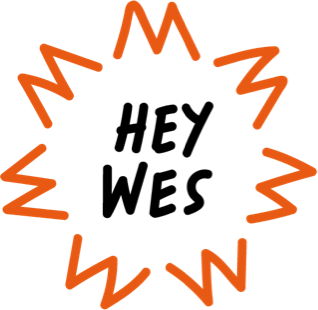LGBTQ+ Terminology
The queer community is filled with beautiful and diverse identities, expressions, and experiences. This glossary of LGBTQ+ terms and definitions was curated by Wes with roots in queer community voices and lived experience. These words and definitions do not belong to any one person or organization–each has its own history and evolution. You will find slight variations in definitions across sources, and that’s okay.

Language holds meaning and impact. It is of the utmost importance that we listen and honor the words and definitions that people use to define and describe themselves, rather than placing words and labels on others.
Let this be a resource that helps us understand each other more fully and sincerely.
This glossary of terms is non-exhaustive. If there is a word or definition that you’d like to see here, reach out to Wes directly.
A
AFAB
An acronym that stands for Assigned Female At Birth and is pronounced “a-fab.” This is appropriate and accurate language to describe cisgender, transgender, nonbinary, and intersex people who were assigned female at birth, regardless of their gender identity or sexual orientation.
Agender
A person who does not identify with any gender. Alternate terms a person may use to describe agender include genderless and neutrois.
AMAB
An acronym that stands for Assigned Male At Birth and is pronounced “a-mab.” This is appropriate and accurate language to describe cisgender, transgender, nonbinary, and intersex people who were assigned male at birth, regardless of their gender identity or sexual orientation.
Androgynous
Describes a person whose gender expression and physical appearance contain close to equal parts femininity and masculinity.
Aromantic
Someone who does not experience romantic attraction. Grayromantic is a term some aromantic people use to describe their place on the aromantic spectrum.
Asexual (Ace)
Someone who does not experience sexual attraction. Gray ace is a term some asexual people use to describe their place on the asexual spectrum.
Assumption Culture
The pervasive, implicit and false messaging that you can know things about other people (e.g., gender, sexual orientation, and more) just by looking at them.
B
Binder
An undergarment worn by someone assigned female at birth who went through female puberty and needs a flat chest in order to feel like themselves.
Bisexual (Bi)
A sexual orientation describing someone who is attracted to more than one gender.
Bottom Surgery
A gender affirming surgery related to an individual’s reproductive anatomy.
Butch
A masculine gender expression most often, but not exclusively, used by queer women and lesbians.
C
Cis Privilege
The advantages cisgender people experience simply because they are cisgender, and not transgender.
Cisgender (Cis)
A person whose gender identity is the same as the gender they were assigned at birth.
Cissexism
Systemtic prejudice in favor of cisgender people.
D
Demigender
A person whose gender identity is partially woman/girl or man/boy but not fully, regardless of gender assigned at birth. Other terms include demiwoman, demigirl, demiman, and demiboy.
Demisexual
A sexual orientation describing someone who only has sexual attraction towards others after forming an emotional connection.
Drag
Theatrical dress and performance of hyperfemininity (e.g., Drag Queen) or hypermasculinity (e.g., Drag King).
F
Femme
A queer woman or person who identifies as feminine.
G
Gay
A sexual orientation describing someone who is attracted to people of their same gender.
Genderless
See ‘Agender’ and ‘Neutrois’
Gender Affirmations
Experiences and actions that support and honor a person’s gender identity.
Gender Affirming Health Care
A variety of medical and mental health interventions that support and affirm a person’s gender identity, when their gender identity is different from the gender they were assigned at birth.
Gender Binary
The belief that there are only two genders and that everyone’s gender identity, gender expression, and gender roles should be in alignment with the expectations of the gender they were assigned at birth.
Gender Dysphoria
Intense and persistent distress that can be experienced when a person’s gender assigned at birth is in conflict with their true gender. Gender dysphoria is often experienced as body dysphoria and/or social dysphoria. Not all trans or nonbinary people experience gender dysphoria, but many do.
Gender Euphoria
The joy or deep satisfaction a person experiences when there is congruence between their internal sense of gender and the way their gender is embodied, expressed and/or perceived. Alternate term: Gender Joy
Gender Expression
The ways in which a person communicates, expresses, and presents their gender outwardly through external factors such as clothing, hairstyle, makeup, jewelry, body language, body hair, mannerisms, voice, social behavior, and more. Gender expression is not an absolute indicator of a person’s gender identity and/or pronouns.
Gender Fluid (Genderfluid)
A gender identity that describes someone who moves or flows between genders.
Gender Identity
An individual’s deep knowing and internal sense of being a woman, man, both, neither, or another gender. Gender identity is not something we can see by looking at someone.
Gender Inclusive Language
Language that is not gender-specific and is inclusive of people of all genders.
Gender Nonconforming (GNC)
A person who visibly defies society’s understanding of what a man/boy or woman/girl should look like or act like.
Gender Queer (Genderqueer)
A gender identity that describes someone whose gender is both or all genders, no gender, or a gender that lands outside of any conventional or static category of gender.
H
Heterosexual (Straight)
A sexual orientation describing someone with a binary gender identity who is only attracted to people with a different binary gender identity.
Homosexual
A sexual orientation describing someone who is attracted to people who have the same gender as them.
Hormone Blockers (Puberty Blockers)
Gender affirming health care for young trans and nonbinary people that enables them time to determine appropriate medical treatment. Hormone blockers make it so that trans youth do not need to endure potentially harmful outcomes of going through a puberty that does not match their gender identity.
Hormone Replacement Therapy (HRT)
Gender affirming health care for trans and nonbinary people who need to or want to medically transition in order to feel and look more like themselves.
I
Intersectionality
Coined by Kimberlé Crenshaw, a term to describe the interconnected nature of social categorizations such as race, class, and gender, and the ways in which these categorizations create interdependent systems of discrimination and disadvantage for individuals and groups.
Intersex
A person born with sex traits or reproductive anatomy that does not fit within the binary categories of male or female.
L
Lesbian
A sexual orientation describing a woman who is attracted to other women.
LGBTQ+
An initialism that is used to represent all currently marginalized and minoritized sexual orientations and gender identities. It stands for Lesbian, Gay, Bisexual, Transgender, Queer or Questioning, plus Intersex, Asexual, Two Spirit, Nonbinary, and more. The term Queer is sometimes used interchangeably with LGBTQ.
M
Misgender
When inaccurate and incorrect gendered language is used about an individual.
N
Neutrois
A person who does not identify with any specific gender. They may feel indifferent or neutral to having a gender, or null or void of gender. Alternate terms a person may use to describe neutrois include genderless and agender.
Non-binary (Enby)
A person whose gender identity is not exclusively woman or man.
P
Pansexual (Pan)
A sexual orientation describing someone who is attracted to people of all genders, or to people regardless of their gender.
Pronouns
Words used in place of a person’s name. The most common pronouns in English are she/her/hers, he/him/his, and they/them/theirs, however there are lots of other pronoun sets and combinations of pronouns that people use.
Q
Queer
A person or group of people whose sexual orientation and/or gender identity falls outside of the established norms of sexuality and gender, specifically outside of heterosexual and cisgender norms.
Notes about ‘Queer’:
– Often used interchangeably with LGBTQIA+
– Can be a sexual orientation or gender identity label on its own in addition to its use as an overarching categorical and community label
– Carries history of being a derogatory slur; Although largely reclaimed, not all LGBTQ+ people identify with the term and some still find it offensive or off putting
Questioning
An important process of discovery and exploration around one’s own sexual orientation, gender identity, and/or gender expression.
S
Sex/Gender Assigned at Birth
The assignment and classification of a person as male, female, or intersex based on anatomy at birth. This is then immediately translated into a gender (i.e., boy or girl).
Sexual Orientation
A person’s feelings of attraction towards other people.
Stud
An identity for Black lesbians with a butch or masculine gender expression.
T
Top Surgery
A gender affirming surgery related to an individual’s chest or breasts.
Trans Man (Trans Boy, Trans Dude, Trans Guy)
A man or boy who was assigned female at birth.
Trans Woman (Trans Girl)
A woman or girl who was assigned male at birth.
Transcestors
A respectable, celebratory, and familial term used within the trans community to refer to the community’s elders and ancestors, past and present.
Transfeminine (Transfemme)
Someone assigned male at birth who has a gender identity and expression that is more aligned with female or feminine.
Transgender (Trans)
An umbrella term describing a person whose gender identity is different from the gender they were assigned at birth.
Transition
The process of changing one’s gender expression and/or physical characteristics to better align with and affirm one’s gender identity.
Transmasculine (Transmasc)
Someone assigned female at birth who has a gender identity and expression that is more aligned with male or masculine.
Two Spirit
An umbrella term referring to another gender role believed to be common among most, if not all, first peoples of Turtle Island (North America), one that had a proper and accepted place within native societies. This acceptance was rooted in the spiritual teachings that say all life is sacred. Two-spirit is a cultural term reserved for Indigenous Native Americans. Definition from The Two Spirit Society of Denver.
